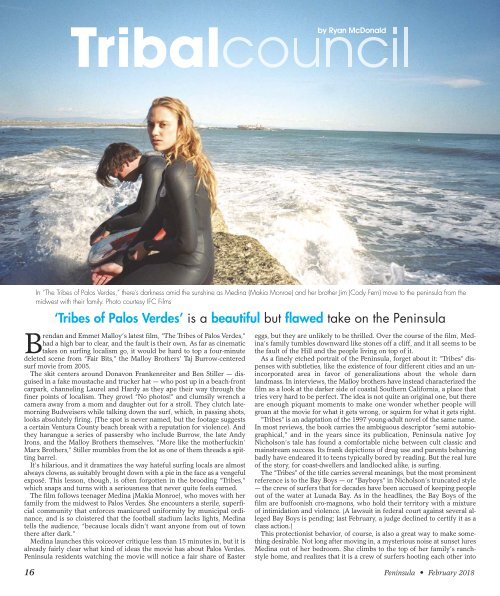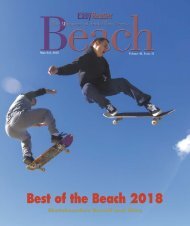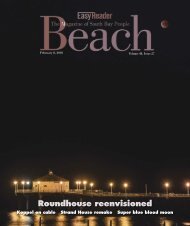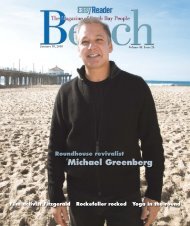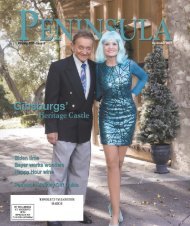Peninsula People Feb 2018
You also want an ePaper? Increase the reach of your titles
YUMPU automatically turns print PDFs into web optimized ePapers that Google loves.
Tribal<br />
by Ryan McDonald<br />
In “The Tribes of Palos Verdes,” there’s darkness amid the sunshine as Medina (Makia Monroe) and her brother Jim (Cody Fern) move to the peninsula from the<br />
midwest with their family. Photo courtesy IFC Films<br />
‘Tribes of Palos Verdes’ is a beautiful but flawed take on the <strong>Peninsula</strong><br />
Brendan and Emmet Malloy’s latest film, “The Tribes of Palos Verdes,”<br />
had a high bar to clear, and the fault is their own. As far as cinematic<br />
takes on surfing localism go, it would be hard to top a four-minute<br />
deleted scene from “Fair Bits,” the Malloy Brothers’ Taj Burrow-centered<br />
surf movie from 2005.<br />
The skit centers around Donavon Frankenreiter and Ben Stiller — disguised<br />
in a fake moustache and trucker hat — who post up in a beach-front<br />
carpark, channeling Laurel and Hardy as they ape their way through the<br />
finer points of localism. They growl “No photos!” and clumsily wrench a<br />
camera away from a mom and daughter out for a stroll. They clutch latemorning<br />
Budweisers while talking down the surf, which, in passing shots,<br />
looks absolutely firing. (The spot is never named, but the footage suggests<br />
a certain Ventura County beach break with a reputation for violence). And<br />
they harangue a series of passersby who include Burrow, the late Andy<br />
Irons, and the Malloy Brothers themselves. “More like the motherfuckin’<br />
Marx Brothers,” Stiller mumbles from the lot as one of them threads a spitting<br />
barrel.<br />
It’s hilarious, and it dramatizes the way hateful surfing locals are almost<br />
always clowns, as suitably brought down with a pie in the face as a vengeful<br />
exposé. This lesson, though, is often forgotten in the brooding “Tribes,”<br />
which snaps and turns with a seriousness that never quite feels earned.<br />
The film follows teenager Medina (Makia Monroe), who moves with her<br />
family from the midwest to Palos Verdes. She encounters a sterile, superficial<br />
community that enforces manicured uniformity by municipal ordinance,<br />
and is so cloistered that the football stadium lacks lights, Medina<br />
tells the audience, “because locals didn’t want anyone from out of town<br />
there after dark.”<br />
Medina launches this voiceover critique less than 15 minutes in, but it is<br />
already fairly clear what kind of ideas the movie has about Palos Verdes.<br />
<strong>Peninsula</strong> residents watching the movie will notice a fair share of Easter<br />
eggs, but they are unlikely to be thrilled. Over the course of the film, Medina’s<br />
family tumbles downward like stones off a cliff, and it all seems to be<br />
the fault of the Hill and the people living on top of it.<br />
As a finely etched portrait of the <strong>Peninsula</strong>, forget about it: “Tribes” dispenses<br />
with subtleties, like the existence of four different cities and an unincorporated<br />
area in favor of generalizations about the whole darn<br />
landmass. In interviews, the Malloy brothers have instead characterized the<br />
film as a look at the darker side of coastal Southern California, a place that<br />
tries very hard to be perfect. The idea is not quite an original one, but there<br />
are enough piquant moments to make one wonder whether people will<br />
groan at the movie for what it gets wrong, or squirm for what it gets right.<br />
“Tribes” is an adaptation of the 1997 young-adult novel of the same name.<br />
In most reviews, the book carries the ambiguous descriptor “semi autobiographical,”<br />
and in the years since its publication, <strong>Peninsula</strong> native Joy<br />
Nicholson’s tale has found a comfortable niche between cult classic and<br />
mainstream success. Its frank depictions of drug use and parents behaving<br />
badly have endeared it to teens typically bored by reading. But the real lure<br />
of the story, for coast-dwellers and landlocked alike, is surfing.<br />
The “Tribes” of the title carries several meanings, but the most prominent<br />
reference is to the Bay Boys — or “Bayboys” in Nicholson’s truncated style<br />
— the crew of surfers that for decades have been accused of keeping people<br />
out of the water at Lunada Bay. As in the headlines, the Bay Boys of the<br />
film are buffoonish cro-magnons, who hold their territory with a mixture<br />
of intimidation and violence. (A lawsuit in federal court against several alleged<br />
Bay Boys is pending; last <strong>Feb</strong>ruary, a judge declined to certify it as a<br />
class action.)<br />
This protectionist behavior, of course, is also a great way to make something<br />
desirable. Not long after moving in, a mysterious noise at sunset lures<br />
Medina out of her bedroom. She climbs to the top of her family’s ranchstyle<br />
home, and realizes that it is a crew of surfers hooting each other into<br />
16 <strong>Peninsula</strong> • <strong>Feb</strong>ruary <strong>2018</strong>


